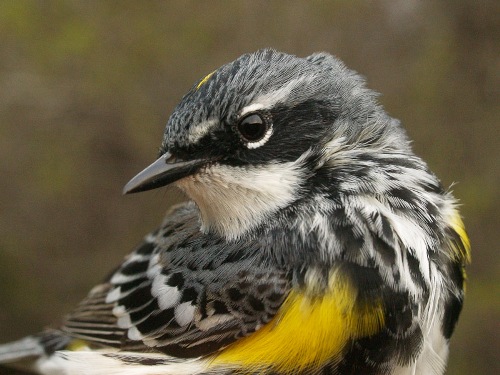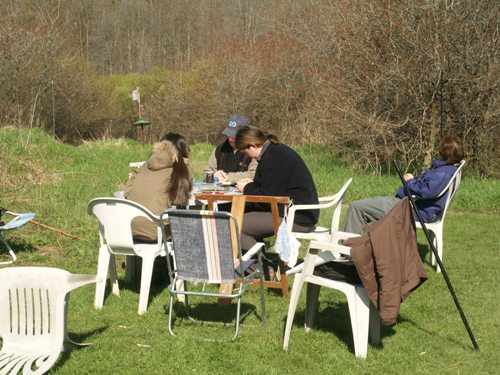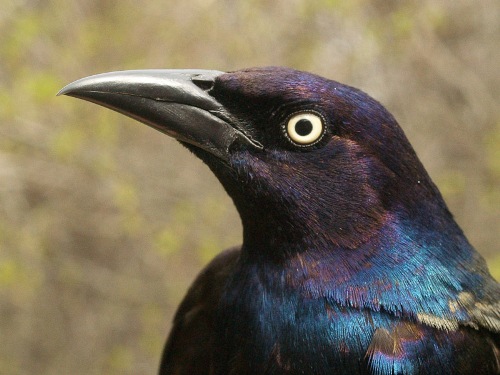|
|
THIS WEEK |
THIS SPRING |
2012 TOTAL |
SITE TOTAL |
# birds (and species) banded |
72 (16) |
174 (24) |
249 (27) |
36000 (108) |
# birds (and species) repeat |
37 (8) |
61 (9) |
75 (11) |
6488 (68) |
|
# birds (and species) return |
11 (4) |
32 (7) |
58 (9) |
1019 (38) |
|
# species observed |
64 |
83 |
85 |
205 |
|
# net hours |
389.0 |
735.0 |
798.8 |
59897.9 |
|
# birds banded / 100 net hours |
18.3 |
23.5 |
31.2 |
60.1 |
|
|
Note: table does not include nocturnal banding (owls) |
Banders-in-charge: Simon Duval, Gay Gruner
Assistants: Christine Barrie, Carl Bromwich, Yolande Cossette, David Davey, Jean Demers, Réjean Duval, Nicola Fleming, Louise Gagné, Sean Godwin, Alison Hackney, James Junda, Lisa Keelty, Barbara MacDuff, Francine Marcoux, Betsy McFarlane, Yves Payette, Benoit Piquette, Catherine Russell, Clémence Soulard, Rodger and Elise Titman, Yifu Wang
Notes: Migration was relatively slow this week, with some cool north winds holding back movement, and a couple of days largely rained out. However, that is typical for this time of year, and the 71 birds banded this week was in fact slightly above the mean of 66 across all previous years and brought us to exactly 36000 overall. However, the number of repeats this week was more than triple the average of 12 for week 5, and nearly double the previous record of 19 in 2008, reflecting the stagnancy of migration this week. The number of species observed in week 5 has varied widely across the years from a low of 55 to a high of 75, and the 64 species this week was right on the seven-year average.

May will bring a rich variety of warblers to MBO, but as usual, the first of the season to arrive was Yellow-rumped Warbler.
(Photo by Simon Duval)
|
Birds observed for the first time this year were Broad-winged Hawk, Barn Swallow, Cliff Swallow, Brown Thrasher, Yellow-rumped Warbler, and Common Yellowthroat. In addition, we saw our first Greater Snow Geese, American Kestrel, and Pine Siskin of spring, although these were previously documented in late winter. We banded four more species for the first time this year (House Wren, Cedar Waxwing, Yellow-rumped Warbler, and Common Grackle), and Black-capped Chickadee for the first time this spring. Also of note this week we had our first Northern Cardinal return of 2012.
This week’s
top 10 [last week's rank in brackets]
#
individuals banded |
mean # individuals observed daily |
1. Red-winged Blackbird (13) [1] |
1. Red-winged Blackbird (83) [3] |
2. American Robin (12) [7] |
2. Canada Goose (69) [1] |
3. White-throated Sparrow (11) [3] |
3. American Crow (26) [4] |
4. Swamp Sparrow (7) [5] |
4. American Robin (21) [2] |
5. Common Grackle (5) [-] |
5. White-throated Sparrow (19) [5] |
6. Ruby-crowned Kinglet (4) [2] |
6. Song Sparrow (18) [8] |
6. Song Sparrow (4) [4] |
7. Black-capped Chickadee (17) [6] |
6. Fox Sparrow (4) [9] |
8. Ruby-crowned Kinglet (13) [10] |
9. Black-capped Chickadee (3) [-] |
9. Greater Snow Goose (13) [-] |
10. Tree Swallow (2) [-] |
10. Ring-billed Gull (12) [9] |
10. American Goldfinch (2) [6] |
|
|
For the fifth time in eight years, Red-winged Blackbird was the species banded most frequently in week 5. Barely behind in second place was American Robin, with as many individuals banded this week as the total across all seven previous years for week 5! White-throated Sparrow was the top species for this week in 2008, and also solidly in the top three this year. This is often a good time of year for Swamp Sparrow; combined with the seven banded last week, the spring total for 2012 is already at 14, above the seasonal average. Rounding out the top five was Common Grackle, which has only made the top ten for week five in two previous years (2006 and 2011). Song Sparrow dropped a couple of spots from last week, while Fox Sparrow jumped up into a tie for sixth place. We banded our first Black-capped Chickadees of the spring, while Tree Swallows tied with American Goldfinch for tenth place, the latter making its sixth appearance in the week 5 list over our eight spring seasons. Purple Finch, Hermit Thrush, and American Tree Sparrow dropped off from last week's top ten.
Red-winged Blackbird displaced Canada Goose from top spot this week, with one of the highest daily averages on record for the species for a spring week. This is particularly surprising, given that Canada Goose has been the most abundant species during week 5 in all seven previous years. Overall, the top five species were the same as last week, but shuffled a bit with American Crow shifting up to third place and American Robin drooping to fourth, while White-throated Sparrow remained in fifth, which is somewhat above average for this time of year. Four of the species in the bottom half of the top ten were also there last week: Ring-billed Gull, Black-capped Chickadee, Ruby-crowned Kinglet, and Song Sparrow, most of which are regulars in the top ten at this time of year. The only new addition this week was Greater Snow Goose, with only one previous appearance in the top ten for week 5, back in 2009. Displaced from last week were Wood Duck and Mallard.
|

A calm, sunny spring morning was a perfect excuse for moving the banding operations outside for a change!
(Photo by Simon Duval)
|



